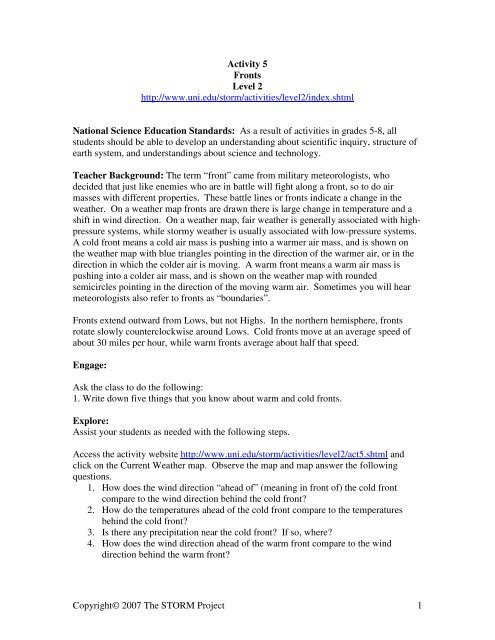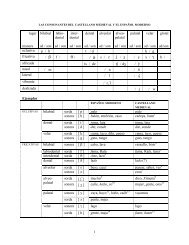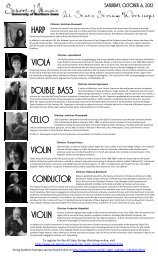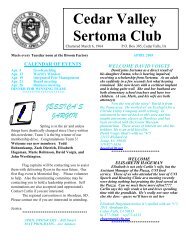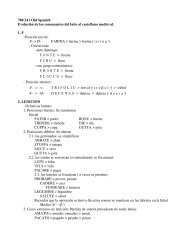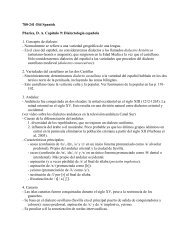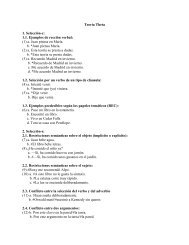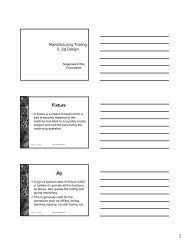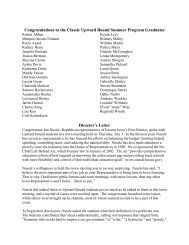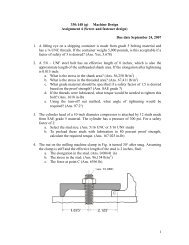Copyright© 2007 The STORM Project 1 Activity 5 Fronts Level 2 http ...
Copyright© 2007 The STORM Project 1 Activity 5 Fronts Level 2 http ...
Copyright© 2007 The STORM Project 1 Activity 5 Fronts Level 2 http ...
Create successful ePaper yourself
Turn your PDF publications into a flip-book with our unique Google optimized e-Paper software.
<strong>Activity</strong> 5<br />
<strong>Fronts</strong><br />
<strong>Level</strong> 2<br />
<strong>http</strong>://www.uni.edu/storm/activities/level2/index.shtml<br />
National Science Education Standards: As a result of activities in grades 5-8, all<br />
students should be able to develop an understanding about scientific inquiry, structure of<br />
earth system, and understandings about science and technology.<br />
Teacher Background: <strong>The</strong> term “front” came from military meteorologists, who<br />
decided that just like enemies who are in battle will fight along a front, so to do air<br />
masses with different properties. <strong>The</strong>se battle lines or fronts indicate a change in the<br />
weather. On a weather map fronts are drawn there is large change in temperature and a<br />
shift in wind direction. On a weather map, fair weather is generally associated with highpressure<br />
systems, while stormy weather is usually associated with low-pressure systems.<br />
A cold front means a cold air mass is pushing into a warmer air mass, and is shown on<br />
the weather map with blue triangles pointing in the direction of the warmer air, or in the<br />
direction in which the colder air is moving. A warm front means a warm air mass is<br />
pushing into a colder air mass, and is shown on the weather map with rounded<br />
semicircles pointing in the direction of the moving warm air. Sometimes you will hear<br />
meteorologists also refer to fronts as “boundaries”.<br />
<strong>Fronts</strong> extend outward from Lows, but not Highs. In the northern hemisphere, fronts<br />
rotate slowly counterclockwise around Lows. Cold fronts move at an average speed of<br />
about 30 miles per hour, while warm fronts average about half that speed.<br />
Engage:<br />
Ask the class to do the following:<br />
1. Write down five things that you know about warm and cold fronts.<br />
Explore:<br />
Assist your students as needed with the following steps.<br />
Access the activity website <strong>http</strong>://www.uni.edu/storm/activities/level2/act5.shtml and<br />
click on the Current Weather map. Observe the map and map answer the following<br />
questions.<br />
1. How does the wind direction “ahead of” (meaning in front of) the cold front<br />
compare to the wind direction behind the cold front?<br />
2. How do the temperatures ahead of the cold front compare to the temperatures<br />
behind the cold front?<br />
3. Is there any precipitation near the cold front? If so, where?<br />
4. How does the wind direction ahead of the warm front compare to the wind<br />
direction behind the warm front?<br />
<strong>Copyright©</strong> <strong>2007</strong> <strong>The</strong> <strong>STORM</strong> <strong>Project</strong> 1
5. How do the temperatures ahead the warm front compare to the temperatures<br />
behind the warm front?<br />
6. Is there any precipitation near the warm front? If so, where?<br />
Explain:<br />
Answer the following questions.<br />
1. What weather would you expect a city to have if it is…<br />
a. ahead of a cold front?<br />
b. behind a cold front?<br />
c. ahead of a warm front?<br />
d. behind a warm front?<br />
Extend:<br />
This activity will assist students in interpreting weather maps on which fronts are<br />
identified. From the activity website,<br />
<strong>http</strong>://www.uni.edu/storm/activities/level2/act5.shtml, access the Current US Weather<br />
map.<br />
1. Locate a city just ahead of a cold front (if one exists today), and write the name of<br />
that city on your paper.<br />
a. What changes in wind direction will you expect for that city as the front<br />
passes by?<br />
b. At the time the front passes the city, what changes do you expect in<br />
temperature?<br />
2. Locate a city just ahead of a warm front (if there is one today), and write the name<br />
of that city on your paper.<br />
a. What changes would you expect in cloud cover for this city as the warm<br />
front arrives?<br />
b. As the warm front passes, what changes would you expect in wind<br />
direction?<br />
c. After the front passes, what changes in temperature would you expect for<br />
this city?<br />
3. In which of the two cities would you expect some type of precipitation?<br />
4. Obtain the same surface map several hours later (or the next day), and write how<br />
well you predicted the weather for the cities.<br />
Evaluate:<br />
1. Collect student sheets.<br />
For Further Inquiry:<br />
As your students, “If cold fronts move about twice as fast as warm fronts, what should<br />
happen to the distance between the fronts over time?” Have students design an<br />
investigation to answer this or any other questions they have about fronts.<br />
<strong>Copyright©</strong> <strong>2007</strong> <strong>The</strong> <strong>STORM</strong> <strong>Project</strong> 2
Engage:<br />
<strong>Fronts</strong><br />
Student Sheet<br />
Answer the following:<br />
Write down five things that you know about warm and cold fronts.<br />
_____________________________________________________________________<br />
_____________________________________________________________________<br />
_____________________________________________________________________<br />
_____________________________________________________________________<br />
______________________________________________________<br />
Explore:<br />
1. Access the activity website <strong>http</strong>://www.uni.edu/storm/activities/level2/ , and click<br />
on the Current Weather map. Observe the map and map answer the following<br />
questions.<br />
2. How does the wind direction ahead of (meaning in front of) the cold front<br />
compare to the wind direction behind the cold front?<br />
3. How do the temperatures ahead of the cold front compare to the temperatures<br />
behind the cold front?<br />
4. Is there any precipitation near the cold front? If so, where?<br />
5. How does the wind direction ahead of the warm front compare to the wind<br />
direction behind the warm front?<br />
6. How do the temperatures ahead the warm front compare to the temperatures<br />
behind the warm front?<br />
7. Is there any precipitation near the warm front? If so, where?<br />
Explain:<br />
Answer the following questions.<br />
2. What weather would you expect a city to have if it is<br />
a. ahead of a cold front?<br />
____________________________________________________________<br />
____________________________________________________________<br />
b. behind a cold front?<br />
____________________________________________________________<br />
____________________________________________________________<br />
c. ahead of a warm front?<br />
____________________________________________________________<br />
____________________________________________________________<br />
d. behind a warm front?<br />
____________________________________________________________<br />
____________________________________________________________<br />
<strong>Copyright©</strong> <strong>2007</strong> <strong>The</strong> <strong>STORM</strong> <strong>Project</strong> 3
Extend:<br />
This activity will assist you in interpreting weather maps that display fronts. From the<br />
activity website access a current weather map.<br />
5. Locate a city just ahead of a cold front (if one exists today), and write the name of<br />
that city on your paper.<br />
a. What changes in wind direction will you expect for that city as the front<br />
passes by?<br />
____________________________________________________________<br />
b. At the time the front passes the city, what changes do you expect in<br />
temperature?<br />
____________________________________________________________<br />
6. Locate a city just ahead of a warm front (if there is one today), and write the name<br />
of that city on your paper.<br />
a. What changes would you expect in cloud cover for this city as the warm<br />
front arrives?<br />
____________________________________________________________<br />
b. As the warm front passes, what changes would you expect in wind<br />
direction?<br />
____________________________________________________________<br />
c. After the front passes, what changes would you expect for this city?<br />
____________________________________________________________<br />
____________________________________________________________<br />
7. In which of the cities would you expect some type of precipitation?<br />
__________________________________________________________________<br />
8. Obtain the same surface map several hours later (or the next day), and write how<br />
well you predicted the weather for the cities.<br />
__________________________________________________________________<br />
__________________________________________________________________<br />
__________________________________________________________________<br />
<strong>Copyright©</strong> <strong>2007</strong> <strong>The</strong> <strong>STORM</strong> <strong>Project</strong> 4


